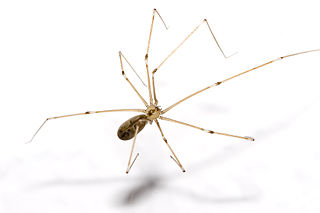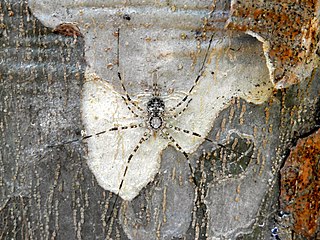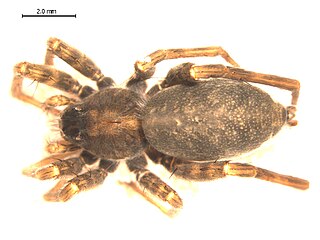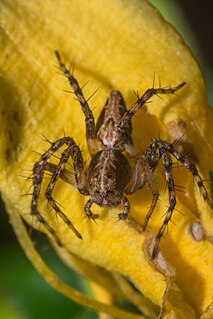
The Pholcidae are a family of araneomorph spiders. The family contains over 1,800 pholcids, including those commonly known as the marbled cellar spider , daddy long-legs spider, granddaddy long-legs spider, carpenter spider, daddy long-legger, vibrating spider, gyrating spider, long daddy, and skull spider. The family, first described by Carl Ludwig Koch in 1850, is divided into 94 genera.

Lampshade spiders, family Hypochilidae, are among the most primitive of araneomorph spiders. There are two genera and twelve species currently recognized. Like mygalomorphs, most hypochilids have two pairs of book lungs, but like araneomorphs they have intersecting fangs, with the exception of some species which have chelicerae in an angle that is neither orthognathous or labidognathous. These long-legged spiders build typical "lampshade" style webs under overhangs and in caves. In the United States the fauna is primarily associated with the Appalachian, Rocky and California Mountains. Ten of the known species are found in these ranges, all in the genus Hypochilus. The genus Ectatosticta is found in China.

Sphodros is a genus of North American purseweb spiders first described by Charles Athanase Walckenaer in 1835. It was considered a synonym of Atypus until 1980.

Neocteniza is a genus of armored trapdoor spiders that was first described by Reginald Innes Pocock in 1895. Originally placed with the Actinopodidae, it was moved to the Idiopidae in 1985.

Aliatypus is a genus of North American folding trapdoor spiders first described by C. P. Smith in 1908. They resemble members of Ctenizidae in morphology and behavior, but this is due to convergent evolution rather than direct relation. They are most closely related to members of Antrodiaetus, which build collar doors. It is likely that the shift from using collar doors to using trapdoors is what allowed them to survive in hot, dry conditions where their closest relatives could not.

Antrodiaetus is a genus of American and Japanese folding trapdoor spiders first described by Anton Ausserer in 1871. The name is a combination of the Greek "antrodiaitos" (αντροδιαιτος), meaning "living in caves", "antron" (αντρον), meaning "cave", and "diaita (διαιτα), meaning "way of life, dwelling".

Hypochilus is a genus of North American lampshade spiders that was first described by George Marx in 1888.
Anthrobia is a genus of North American dwarf spiders that was first described by T. Tellkampf in 1844.

Hypochilus coylei is a species of lampshade weaver in the family of spiders known as Hypochilidae. It is found in the United States. This species inhabits a 35 mile north-south corridor of mountain range in western North Carolina. This species has a two year life cycle and feeds on crickets and spiders.

Neotama mexicana, also known as the long-spinneret spider or Mexican two-tailed spider, is a species of tree trunk spider in the family Hersiliidae. It is found in a range from the United States to Peru and Guyana.

Hentzia mitrata, the white-jawed jumping spider, is a species of jumping spider in the family Salticidae. It is found in the United States, Canada, and Bahama Islands.
Habronattus sansoni is a species of jumping spider in the family Salticidae. It is found in the United States and Canada.
Pityohyphantes costatus, the hammock spider, is a species of sheetweb spider in the family Linyphiidae. It is found in the United States.

Pardosa lapidicina, the stone spider, is a species of wolf spider in the family Lycosidae. It is found in the United States and Canada.
Xysticus emertoni, or Emerton's crab spider, is a species of crab spider in the family Thomisidae. It is found in the United States, Canada, Slovakia, Russia, and a range from Central Asia to China.

Pirata piraticus is a species of wolf spider in the family Lycosidae. It is found in North America, Europe, Turkey, Caucasus, a range from Russia, Central Asia, China, and Japan.
Phrurotimpus borealis is a species of true spider in the family Phrurolithidae. It is found in North America.

Oxyopes scalaris, the western lynx spider, is a species of lynx spider in the family Oxyopidae. It is found in North America.












